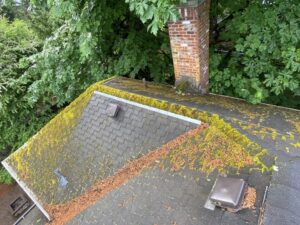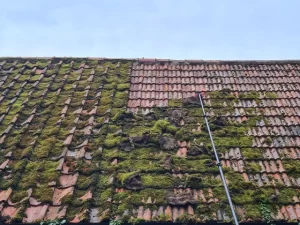Maintaining a roof is crucial for ensuring the longevity and safety of a home. Over time, weather conditions, debris, and biological growth like moss can deteriorate roofing materials, leading to costly repairs. A well-structured yearly maintenance schedule can help prevent damage and extend the lifespan of the roof.
Creating a maintenance plan involves regular inspections, cleaning, and specific measures to address common issues like moss growth. Understanding how to structure a schedule that accommodates seasonal variations and regional climate conditions is essential for homeowners who want to protect their investment.
Understanding the Importance of Regular Roof Maintenance
 A roof is constantly exposed to the elements, making it vulnerable to wear and tear. Sun exposure, rain, snow, and wind contribute to the gradual breakdown of roofing materials. Without routine maintenance, minor issues can escalate into significant structural problems.
A roof is constantly exposed to the elements, making it vulnerable to wear and tear. Sun exposure, rain, snow, and wind contribute to the gradual breakdown of roofing materials. Without routine maintenance, minor issues can escalate into significant structural problems.
One of the most common challenges homeowners face is moss growth, particularly in regions with high humidity and frequent rainfall. Moss can retain moisture, causing roofing materials to weaken over time. If left untreated, it can lead to leaks, wood rot, and even structural damage. Addressing moss and other potential issues as part of an annual maintenance plan can prevent expensive repairs.
Planning Seasonal Roof Inspections
A well-planned maintenance schedule should include inspections at least twice a year—once in the spring and again in the fall. These seasonal inspections allow homeowners to assess damage caused by winter storms or summer heat and prepare the roof for the coming season.
Spring is an ideal time to check for any damage caused by ice, snow, and freezing temperatures. It is also an opportunity to clear away fallen leaves, branches, and other debris that may have accumulated over the winter. Checking for loose shingles, cracks, and signs of wear can help address problems before they worsen.
Fall inspections are equally important, as they prepare the roof for the harsher conditions of winter. Ensuring that gutters are clear and that the roof is free from moss, lichen, and algae growth will help prevent moisture-related damage during the colder months. Professional Roof Moss Removal Hillsboro Oregon services can be particularly beneficial during fall maintenance, ensuring that moss is thoroughly removed and preventative treatments are applied to protect the roof throughout the winter.
Addressing Moss Growth Throughout the Year
Moss thrives in damp, shaded areas, often forming on north-facing roofs or areas with overhanging trees. Once established, it spreads quickly, absorbing moisture and creating an environment that accelerates roof decay.
Preventing moss growth starts with trimming back tree branches to increase sunlight exposure and improve airflow. Keeping the roof dry will make it less hospitable for moss to take root. Regularly clearing leaves and organic debris also helps reduce the risk of moss formation.
If moss has already developed, it must be carefully removed to avoid damaging the roofing material. Using a gentle cleaning solution designed for roof surfaces can help eliminate moss without causing harm. A mixture of water and mild detergent or a specialized moss removal product can be applied with a soft brush or sprayer.
Once the moss has been treated, rinsing the area with low-pressure water can help wash away any remaining residue. High-pressure washing should be avoided, as it can strip away protective layers on shingles and reduce their lifespan.
Cleaning and Maintaining Gutters
Gutters play a vital role in directing water away from the roof and foundation of a home. Clogged gutters can cause water to back up, leading to leaks, ice dams, and structural damage. Regularly checking and cleaning gutters should be an essential part of any roof maintenance plan.
During spring and fall inspections, removing leaves, twigs, and other debris from gutters will help ensure proper water drainage. Checking for any signs of rust, sagging, or detachment from the roof is also necessary to maintain the effectiveness of the gutter system.
Installing gutter guards can help minimize the amount of debris that accumulates, reducing the need for frequent cleaning. Ensuring that downspouts direct water away from the foundation will further protect the home from potential water damage.
Checking for Structural Damage
In addition to moss removal and gutter maintenance, inspecting the overall condition of the roof structure is essential. Looking for loose or missing shingles, cracks, and signs of water damage can help detect issues early. If there are any signs of sagging, rot, or mold growth, addressing these problems promptly will prevent further deterioration.
Flashing, which seals areas around chimneys, vents, and skylights, should also be checked for cracks or gaps. Damaged flashing can lead to leaks, making it an important aspect of roof maintenance. Sealing any openings with roofing sealant or replacing damaged flashing can help maintain the roof’s integrity.
Preparing for Winter Weather
Before winter sets in, taking preventive measures can help protect the roof from damage caused by ice and snow. Ensuring proper attic insulation and ventilation will help regulate temperature and prevent the formation of ice dams.
 Ice dams occur when warm air from the attic causes snow to melt and refreeze at the edges of the roof, leading to water buildup under the shingles. This can result in leaks and structural damage. Proper insulation reduces heat loss, while adequate ventilation allows warm air to escape, reducing the risk of ice dam formation.
Ice dams occur when warm air from the attic causes snow to melt and refreeze at the edges of the roof, leading to water buildup under the shingles. This can result in leaks and structural damage. Proper insulation reduces heat loss, while adequate ventilation allows warm air to escape, reducing the risk of ice dam formation.
Checking for any weak spots or vulnerabilities in the roof before winter arrives can help avoid emergency repairs during the colder months. If there are any concerns about the roof’s ability to withstand heavy snow, consulting a professional for an inspection is advisable.
Knowing When to Call a Professional
While many aspects of roof maintenance can be handled by homeowners, certain tasks require professional expertise. If there are significant structural issues, extensive moss growth, or persistent leaks, seeking professional assistance is recommended.
A roofing professional can conduct a thorough inspection, identify hidden problems, and provide solutions that ensure the roof remains in good condition. Professional moss removal services may also use specialized treatments to prevent regrowth, offering long-term protection.